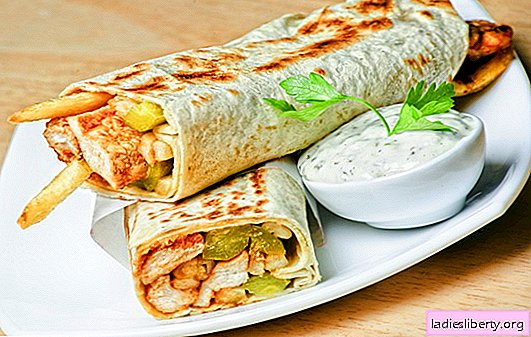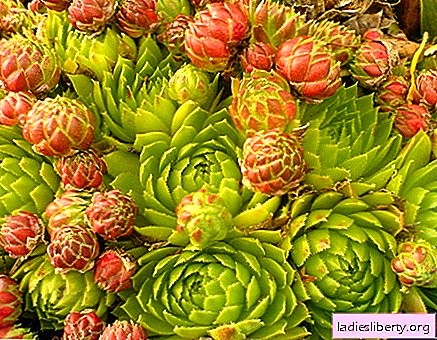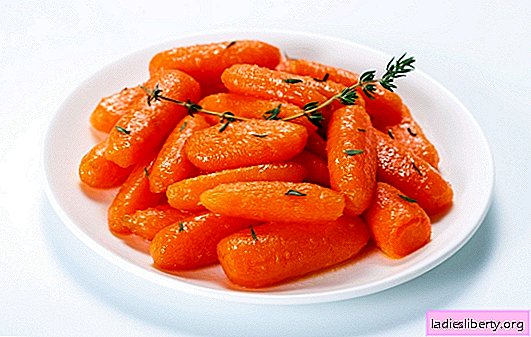
Growing dahlias is possible even for a novice grower.
Bright and diverse in shape and color of flowers will be a worthy decoration of any site.
To bloom was lush and long, you need to study the agrotechnology of growing dahlias.

Growing Dahlias: Choosing Planting Material
The choice of planting material depends on the place of planting, climatic zone, variety, cultivation purposes (for cutting, as a border plant, in gardening of balconies, etc.), resistance to diseases, keeping quality, and vegetation periods.
The planting material of dahlias can be represented in the form of seeds, delok with awakened buds, rooted cuttings, seedlings.
When choosing seeds you need to carefully examine the information on the package: the size of the inflorescence, the expected height of the plant, the timing of flowering. Dahlia seeds are grown as an annual crop.
The "right" delenka should look like this: a small stump of last year's stem, root neck has 2-3 buds of growth and tubers well spliced with it.

In appearance, the rootclub should be dense, not shriveled, without spots of rot and mold, of medium size. This is exactly the case when “size matters”: large or huge tubers (unless it is a sign of variety) with a dark wrinkled surface indicate that they are taken from an age (3-4 year old) bush. A new plant will grow from them, but does not form new tubers in the fall.
Rooted cuttings and seedlings better to buy in May, shortly before landing in the ground.
Grow dahlias: planting
Choosing a place
Dahlias do not like the neighborhood of large trees. For growing dahlias, a sufficiently illuminated area, protected from the wind, is diverted. Lowland places for these colors are not suitable: cold air prevails in them, frosts occur earlier than in elevated areas. Heat-loving dahlias in such conditions grow poorly, the stems are drawn out, weak tubers are formed.
The soil
For the cultivation of dahlias suitable loamy or fertilized sandy soil. To enrich it in the fall, humus or peat compost (3-4 kg / m2) are introduced and dug to a depth of 0.2-0.3 m. In the spring, mineral fertilizer is added (60-80g per 1 m2). In the sandy mountains, it is recommended to add trace elements in the form of aqueous solutions.
Pre-preparation
Before planting, dahlias can be propagated by roots, cuttings, seeds or grafting.
Vaccination on the root jar quite complicated technique, so it is rarely used.
Reproduction tubers and cuttings used for semi-terry and terry varieties. In this case, the plants retain varietal characteristics.
Before dividing the tubers inspect and sort. Do it in the last days of March. For germination, they are laid out at + 12-16 ° C on moistened sand or peat in suitable containers (boxes, pots). When the sprouts that have appeared reach 1-2 cm, you can proceed to the division: with a sharp knife, the root-club is cut so that each separate part has a piece of the root collar with 1-2 buds.

Sections are powdered with crushed coal to avoid rotting and put in 11-12 centimeter pots. Long tubers can be shortened to the bottom by 1 / 2-1 / 3 length, so that it is more convenient to plant them.
Sprouted shoots on tubers can be grafted when they reach the size of 5-7 cm (in the presence of 3-4 leaves). The stalk is cut under the internode. They are planted in pots with light sandy soil to a depth of 2 cm.

After 2-3 weeks, rooted cuttings are planted in separate pots.
Vegetatively propagated varieties age and degenerate over time.
Seed propagation used for breeding new varieties, growing annual species and mini dahlias. Tubers do not propagate them because of poor keeping quality. Dwarf dahlias grown from seed retain low growth and bloom profusely. Sow them in the 2nd half of March. Dive one by one in a 7-cm pot.
Landing dates
Planting dahlias in open ground depends on the climatic conditions of the area. As soon as the soil warms up (the second half of May), it is possible to plant root crops. Seedlings from seeds, cuttings, podroshchennye delenki planted after the passing of frosts. The optimal time for this is the last decade of May - the beginning of June. In order to avoid damage to landings by frosts, it is necessary to have a covering material on hand. Lagging with planting is also not recommended, this leads to the fact that the plants are drawn out, their flowering intensity decreases, and the aging of the roots is worsened.
How to plant dahlias?
The planting pattern is determined depending on the height of the variety:
• for dwarf - 50 cm;
• for sredneroslyh - 60-70cm;
• tall - 90 cm.
Between the rows, the distance should be at least 1 m. This will provide a sufficient food area for each bush and make it easier to care for. The wells are made with a depth of 20-25 cm, with a diameter of 30-35 cm. 2-3 tablespoons of wood ash or 10-15 g of mineral fertilizers are added to the hole, mixing them with the ground. Dahlias are planted in such a way that the root neck is 3-5 cm deep in the soil. When planting large unseparable tubers, it is recommended to pour a small mound of earth on the bottom of the fossa and spread the roots radially on it.

Cutting plants are planted even deeper - to the first true leaves. Immediately after planting, seedlings must be watered abundantly.
Growing dahlias: care
Caring for dahlias is not complicated. It includes tying up, pinching, watering, loosening, dressing.
Dahlias of tall varieties need garters to the stakes, because they break easily in strong winds. It is better to put the support immediately upon planting, so as not to damage the root-plant.
Watering and loosening
The amount of watering depends on weather conditions. In the heat of the planted plants watered every day, morning and evening. The lack of moisture during this period contributes to the reduction of development, lignification of the stem, reduction of flowering. Further, the frequency of watering regulate as needed. During the period of bud formation and early flowering, watering increases.
Land under the dahlias should be loosened every time after watering or fertilizing. After the closure of the bushes, the loosening is stopped. Excellent results are obtained by mulching: the ground around dahlias is covered with humus or peat 5–8 m thick. This provides better heating of the soil, preservation of moisture, retarding the growth of weeds, reduces the need for loosening.
Fertilizer
Organic fertilizers such as mullein, bird droppings are used for fertilizing. They are made in the form of water infusion 1:10 and 1:20, respectively. The first feeding should be no earlier than 15 days after planting. If fertilizers are applied to the well during planting, then the next time you can feed the plants no earlier than a month.
How to speed up the blooming of dahlias?
The following measures contribute to earlier flowering:
• early landing (under cover);
• reduced daylight hours;
• formation of a bush;
• pasynkovanie.
To reduce daylight hours, young plants need to arrange an “artificial night”: from 15-16 o'clock in the afternoon they are covered with opaque material (black film or thick paper), and removed early in the morning. This procedure is carried out for 3-4 weeks. If usually dahlias bloom in late July - early August, then the plants subjected to a reduced light day, bloom a month earlier.
For large-flowered dahlia bushes, it is enough to leave 1-2 strong shoots; the weaker ones must be removed. At the grafted plants leave 1 stalk. Form a bush after the appearance of stepsons. To do this, they are regularly removed to the last internode before the buds. If the side shoots are left, especially in the lower part of the stem, the flowering will be reduced as a result, the flowers will be smaller. Dwarf varieties of dahlias do not stepchildren.

In vigorous varieties also cut off the lower leaves. This procedure contributes to the ripening of tubers, increases their keeping quality during storage.
If dahlias are grown for cutting or for the exhibition, then during the budding period, the average buds should be removed from such specimens. They grow faster, but have a short flower stalk. After their removal from the side buds, long stalks with lush flowers develop.
Dahlia blooms before cooling, giving up to 15-25 inflorescences from one plant. With the onset of the danger of frost, they are being pounded to a height of at least 15-20 cm in order to keep the lower part of the stem from freezing. This may cause rotting of the root collar and the death of root tubers.
Dahlia storage
Dahlia leaves withstand short frosts up to -1 ° C, stems up to -2 ° C. Before digging the aerial part of the plant is cut, leaving 15-18 cm of the stem. Korneklubni dig in dry weather, carefully undermining from all sides. Pulling them should not be in order to avoid the separation of individual tubers. To prevent diseases, the tubers are disinfected in an average solution of potassium permanganate (30 minutes) or dipped in lime mortar (200 g of lime per 1 l of water). After that, dried and placed in boxes with coniferous sawdust or perlite for winter storage. The temperature in the room where the root crops are stored should be + 5-7 ° С. The storage site must first be disinfected with iron sulfate, potassium permanganate.

The main pests and methods to combat them
Aphids - the most common pest. There are greenish-yellow or brown in size up to 2mm. They multiply rapidly in dry hot weather, settle in colonies at the bottom of leaves, on young shoots, and buds. They suck the sap of the plant, causing the shoots to bend, leaves curl, turn yellow, covered with sticky insect secretions. To destroy aphids, dahlias are sprayed with insecticides Aktara, Fitoverm, Konfidor.

Drooling pennitsa - these are small (5-6 mm) cicadas, the caterpillars of which live in the “saliva” they excrete - a foamy sticky liquid. They suck the sap of the plant. Damaged leaves shrink, turn yellow and wither. Of the chemicals for the destruction of insects use Inta-Vir, Fufanon.

Nematode - filamentous worm 1 mm in size. It affects the buds, leaves. First, leaf blades become stained, decay and fade. With further damage the leaves turn brown and crumble. Sick plant with a lump of earth and burn. The soil in the contaminated area is treated with bleach.

Spider mite barely visible to the unaided eye: it is a small insect up to 0.5 mm in length. It multiplies rapidly in dry weather. Sucks the sap of plants. Dimpled points are observed on injured leaves in places of bites. Gradually the foliage turns pale and dries. For the destruction of ticks use insecticides Fitoverm, Talstar, Flumayt.

Cabbage scoop - it is a moth of gray color. Lays its eggs on the leaves from the bottom. Harm inflict green caterpillars, eating the flesh of the leaves. When a pest is detected, it is necessary to use the drugs Decis, Spark, Confidor, Leptocide.

Scoop-gamma: butterflies are gray-brown in color, flying at dusk and at night. They themselves are not dangerous for plants. Hatching eggs greenish-yellow or green caterpillars gnaw leaves and buds. Single caterpillars are harvested by hand, with a large number of pests using spraying dahlias with insecticides (Iskra-M, Fufanon), a solution of wood ash (200 g of ash, 1 tablespoon of green soap in a bucket of water).

Slugs feed on juicy parts of dahlias: petioles, leaves, young stems. For their destruction use wet traps (wet rags, boards, vegetable residues). You can pour around the plants "track" of crushed eggshell, ash, crushed bricks. Use of chemicals only in extreme cases.

Bronze shaggy - Black beetle with yellowish or white spots on the sheath. Eats buds and flowers. Fighting them consists in mechanically shaking off beetles from plants and destruction. If there are many pests, the use of Confidor is justified.












